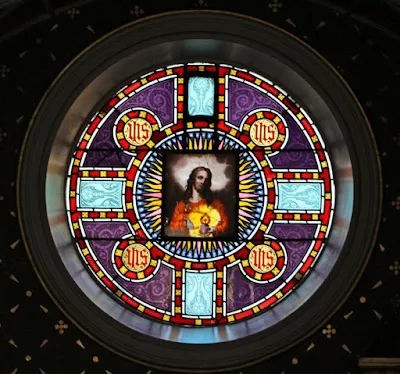An Image of the Sacred Heart Containing Flowers of the Tree of Life in Paradise
This is the final article in a series of three. In Part 1, I developed the idea of the impulse for beauty as a principle for choice that complements the moral conscience. In Part 2, I suggested ways in which the creative impulse for beauty can be stimulated and formed in our own lives, drawing on the artistic and spiritual tradition of the Church. I now focus on a single painting of the Sacred Heart of Jesus which is embedded with design principles that conform to the pattern of beauty that can permeate our lives too.
Let us consider an image that is ordered to the number eight in a way that might be surprising. This image is of Christ as the flower of the new Tree of Life, containing a seed that dies and then germinates to new life in us, as described in the Gospel (John 12, 24-26). We who are joined to Christ through the Eucharist can become flowers of paradise too.
The 6th-century saint Boethius, in his book
De institutione arithmetica, describes the proportion 3:5:8 as one of among ten, which is musically derived. Amongst the others is one he calls The Fourth of Four, one from a group of four related proportions. In this book, Boethius does not ascribe any Christian significance to the numerical relationships; he is simply content to describe the mathematical basis of proportions commonly held to be beautiful. The Christological symbolism comes, I suggest, from the significance of the individual numbers of that proportion in Christian numerology: 3 is the number of the Trinity and spiritual life, 5 is the number of humanity (from the fact that we have five senses), and 8 (the sum of three and five), is the number of Christ, who is simultaneously God and man. This is also, incidentally, the proportion of the idealized man as described by the Roman author Vitruvius in his textbook written for architects in the 1st century AD.
The image of the Sacred Heart seen below includes a portrayal of the Flower of Christ in paradise. Each of the four rectangles that form the arms of a cross in the border contains a stylized representation of a plant which consists of a bulb containing a triangle, connected to a stem, which has a five-petalled flower or seed.
The bulb, or root, is the Trinity; the five-petalled flower, represents his humanity, and the plant as a whole, numerically represented by the number eight – three plus five – is the Flower of Christ in paradise. The Fruit that comes from this flower is that of the Tree of Life, forbidden to Adam and Eve, and which is now offered to each of us in the Eucharist.
Partaking of the divine nature as part of the Church, we too become spiritual flowers in Paradise. Christ is the fruit of those heavenly blooms, and He is offered to those who are drawn in by the sweet fragrance emanating from the flower, which corresponds to the love of Christ we perceive, one hopes, in our lives. It is the beauty of our lives that directs others to the source of that beauty, Christ.
The impulse to beauty, that conscience of creativity in our hearts, when attuned to the beauty of Christ, helps us to be by degrees an ever-more brilliantly colored, beautifully formed, and sweetly fragrant Christ-like Flower of Paradise. Unlike the natural flower, this one does not fade, wither and die in time. Rather, it becomes steadily more perfect and radiant in its beauty as we lead a Christian life, reaching the fullness of perfection when we are in union with him in the next life. We become eternal flowers in paradise.
“Jesse rejoices and David exults. Behold, like a branch planted by God, the Virgin has brought forth Christ, the eternal flower!” (From Morning Prayer on the Sunday of the Myrrh-Bearing Women, the second after Easter in the Byzantine Rite.)
 |
The Maryvale Sacred Heart, painted by David Clayton; egg tempera on wooden panel, based upon a traditional design. |
The painting above was commissioned in 2005 for the chapel at the Maryvale Institute in Birmingham, England, and is based upon a stained-glass window made in France in the 18th century which is in a side chapel at the Institute, the national center for the devotion to the Sacred Heart.


